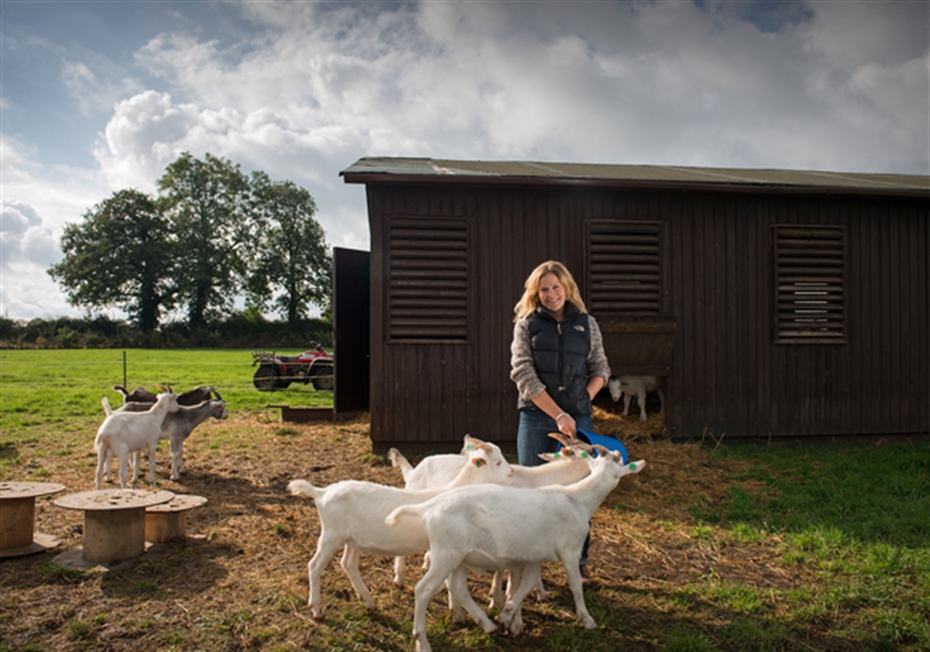
Specialist billy kid rearer Lizzie Dyer relies on LAMLAC to give these unwanted by-products of the burgeoning goat milk industry the right start they need to some sort of life. The proven milk replacer also maximises growth rates pre-weaning and helps deliver a high quality, nutritious kid meat product that is lower in fat than chicken and higher in iron than beef.
Interest in goat milk is growing in the UK, so the number of nannies (female goats) being milked has increased dramatically. Sadly, as is so often the case with bull calves from the dairy cow enterprise, nearly all the milking goat farms in the UK view billy kids as a waste by-product offering little or no value. But thanks to entrepreneur Lizzie Dyer, many of these unwanted young male goat offspring are now being turned into a sustainable source of red meat.
Lizzie runs Just Kidding at Dartland Farm, a 30-acre unit near Cricklade in Wiltshire. She started with just 20 kids four years ago with her partner James Beard, but now rears up to 600 each year to meet a growing demand for the meat from local restaurateurs and the general public. Dartland Farm is now the largest free-range goat meat-producing unit in the country.
“Although kid meat may not be a staple yet on the British menu it is a very healthy and tasty red meat. In fact, goat meat is the most widely eaten meat in the world. It is now becoming more popular in this country and people who try it typically become converts, many describing it as being very similar to spring lamb,” Lizzie says.
Sourcing billy goat kids
Lizzie sources her billy goat kids from one high health status dairy goat farm. They arrive at Dartland Farm at about a week old, batched into pen groups of 10-15 animals and are reared on ad lib LAMLAC via an automatic Volac ECO Feeder until weaning. Breeds tend to be British Saanen, British Alpine or British Toggenburg.
“There is no blueprint for kid meat production, so we have had to learn and adapt our system to best suit our billies.”
Lizzie says that as is the case with calves, in particular, she has learnt that it pays to maximise early life growth potential.
“You have to invest in quality nutrition early and attention to detail, otherwise the kids won’t grow quickly and healthily. The clock is ticking as soon as the animals arrive so you have to be on it, simply because you don’t have the same sort of rearing time luxury that you get with lambs. But we find that if we are able to hit our weaning weight requirement we are halfway there. However, if we miss this target weaning weight they never really catch up.
“We have also found that it pays dividends to give the young kids access to good quality hay. This effectively acts like a ‘toothbrush’ to the developing rumen, stimulating it to develop much faster.”
After weaning the kids are moved to another building that offers shelter, but also allows them access to pasture, which Lizzie regularly analyses for its nutritional content. “We test the grass and then supplement accordingly. The kids that go out in the spring and summer don’t tend to need much supplementary feed, but the winter batches tend to eat more to make up the nutritional shortfall.”
The kids are slaughtered when they reach a target finishing weight and kill out at about 50%.
“It’s just great to be able to maximise the value of these previously unwanted animals and give them a decent life. All the kids are kept in a free range, natural environment and we also process all our own meat, which allows us to have full control of the production process.
Rearing goats
“Goats in general are rather mischievous and very inquisitive, but kids are even worse. They just love playing and getting into trouble so we give them plenty to climb and play on to keep them from getting bored. There really is never a dull moment on the farm.
“I have had a long interest in goats, which I think stemmed from my travels abroad, particularly in India. I also love cooking and trying new ingredients, so its wonderful to be able to combine these passions is such a productive and sustainable way,” Lizzie says.
Volac Lamlac is the UK's No. 1 ewe milk replacer, also suitable to feed goat kids. To find out more about Lamlac, download the full product brochure here or enquire about this product.